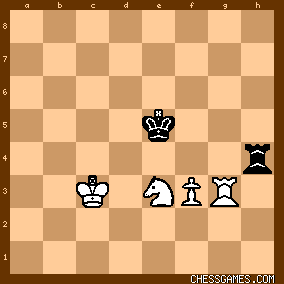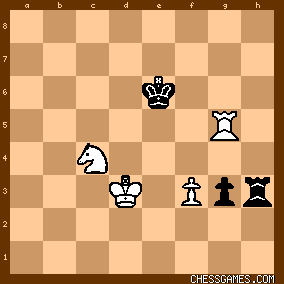|
< Earlier Kibitzing · PAGE 3 OF 3 ·
Later Kibitzing> |
| Apr-14-10 | | Andrijadj: White has about 10 ways to win this,so this is not a good puzzle... |
|
| Apr-14-10 | | kevin86: 68 ♔b4!!!. Mate is inescapable! Holy Cow!! |
|
Apr-14-10
 | | chrisowen: 67.hxg3 is there any hope guv? A silly Smyslov is at sixes sevens. I hazard guess Kb4 and the dicey king sees a tragedy, even from darkness of Rd6+. Act to save him is futile, rook is set on shaking him down. The attack is somewhat taylor made, it is a skinner with the horse. Cart over the king and chores are or job is finished. |
|
| Apr-14-10 | | agb2002: <TheaN: To be honest, moves like 68.Rxg6 probably win and evaluate so high because after for example 68.Rxg6 Rh3, in order to play 69....g2 and win Pf3, White may still mate Black by Kb4. If you don't see that, evaluations probably drop quickly.> I also missed 68... Rh3, probably because it looked to me like a very passive defense, but after 69.Ne3+ Ke5 70.Kd3 g2 White wins with 71.Ke2. If 71... Kf4 72.Rxg2 Rxf3 73.Rg4+ wins the rook. |
|
| Apr-14-10 | | Willem Wallekers: Kb4 is a great move, but a puzzle with two solutions is not a great puzzle. |
|
| Apr-14-10 | | sethoflagos: Just for completeness:
68. Kb4 Rb2+
69. Nxb2 Kd4 the 'other' escape
70. Nc4 Kd3
71. Rxg6 Ke2
72. Rxg3 Kf2
73. f4 Kxg3 (73. Rh3 is slower)
74. f5 Kf4
75. f6 Ke4 arbitrary meandering
76. f7 Kd4 ditto
77. f8=Q Ke4 ditto
78. Kc5 Kd3 (78. Kc3 Kd5 also # in 4)
79. Qf4 Ke2
80. Kd4 Ke1
81. Kd3 Kd1
82. Qd2# |
|
| Apr-14-10 | | Patriot: I missed the main line and went with 68.Rxg6. I also saw the "flight" square on d4 if 68.Kb4 as <dzechiel> stated, but completely missed the mate. That's an unusual mate and in the center of the board! |
|
| Apr-14-10 | | YouRang: It's always very impressive to see such "open field" mate threats with sparse pieces. Today, I failed to be very impressive. :-\ However, I'm sure I would win this. I went for the relatively pedestrian 68.Rxg6, expecting perhaps 68...Rh4 (threaten N) 69.Ne3+ Ke5 (what else?) 70.Rxg3! [diagram]

click for larger view
At first I was worried about 70...Kf4 (forking N+R), but then 71.Rg4+! either wins the rook (boiling down to elementary K+R v K win), or 71...Rxg4 72.fxg4 (which boils down to an elementary K+N+P v K win). |
|
Apr-14-10
 | | Jimfromprovidence: <TheaN> <To be honest, moves like 68.Rxg6 probably win and evaluate so high because after for example 68.Rxg6 Rh3, in order to play 69....g2 and win Pf3, White may still mate Black by Kb4. If you don't see that, evaluations probably drop quickly.> Not true. 68 Rxg6 Rh3 wins easily as well for white. The idea is to check the king to the 6th rank, then move the king towards black's remaining pawn. The pawn can't be saved. Something like 69 Rg5+ Kd6 70 Kd3 should do the trick.

click for larger view |
|
Apr-14-10
 | | benveniste: I admit, I wouldn't have gotten this one over the board. Instead, I would have grabbed the two pawns and ground it out over 30 moves. |
|
| Apr-14-10 | | Samagonka: OKay; THAT WAS HARD!!! |
|
| Apr-14-10 | | MaczynskiPratten: A little knowledge is a dangerous thing ... my gut feel was that a N and R in the middle of the board couldn't restrict Black's King enough to force mate, so was looking at 68 Rxg6 and combinations linked with Ne3+. But the White f3 pawn covers e4, and when I saw that Kb4 had been played the penny dropped .... Doh!!! |
|
| Apr-14-10 | | VincentL: In this "medium/easy" position, white is threatening mate, with Kb4 followed by Rd6. Black also can queen his g pawn in two moves.
Let's start 68. Kb4 Rb2+ (only move to stop the mate) 69. Nxb2 Now if 69.... g2 70 Rxg6 and wins.
If 69..... g5 70. Rf5+ Kd5 71. Rxg5 and wins
If 69..... Ke5 70. Rxg6 Kf4 71. Rf6+ Kg5 72. Rf8 Kh4 73. Rg8 Kh3 74. f4. Now, white will give up his rook for the black pawn, and then queen the f pawn. If black plays 71. Ke3 in this line then 72. f4 the result is the same. White gives up R for P, and queens the f pawn. Time to check. |
|
| Apr-14-10 | | JohnBoy: The obvious 68.Rg6 wins, but is not nearly as aesthetically pleasing (or efficient) as the text move. I wish I had seen the solution rather than focusing on the possibility of Rxg2 and a knight fork at e3. BUT, interesting to me is whether black had to give up the x at move 60. Is that the only way to try for survival? |
|
| Apr-14-10 | | MaczynskiPratten: <JohnBoy>; yes, very interesting question. Looking at it, it seems that if 60..Bc8 or Ba8, White plays 61 b6! threatening Rd8. If 60...Ba8 61 b6 Kc8, 62 Rd7 looks to win the f pawn and maintain the mate threat. Maybe this was why Black felt he had to give up the B and eliminate the b pawn. |
|
Apr-14-10
 | | FSR: 68.Kb4!! and Black stands up. |
|
| Apr-14-10 | | DavidatHunter: In a rare moment of clarity (comes and goes in chess, just as in life), I first examined the Rook checks and seeing that Rd6 is mate except for the c5 escape square, I then looked around for other possibities and, not spotting anything else, then tried to plug the c5 escape square, with Kb4 being the only move. I saw the Rb2+ check on the file was covered by the Knight and then tried to see if anything else could stop the mate-in-one threat. Bingo! |
|
| Apr-14-10 | | Marmot PFL: Simple win, ex. 68 Rxg6 g2 69 Rxg2 Rxg2 70 Ne3+ Ke5 71 Nxg2, but Kuzmin's 68 Kb4! is best. |
|
| Apr-14-10 | | ZZer: Fantastic! |
|
| Apr-14-10 | | johnlspouge: Wednesday (Medium/Easy)
G Kuzmin vs Smyslov, 1978 (68.?) White to play and win.
Material: N for P. The Black Kd5 has 1 legal move, c5. The constricted Kd5 suggests a mate, which requires control of c5. Only one White piece, Kc3, can control c5 immediately, suggesting the candidate 68.Kb4. The White Kc3 is vulnerable to the pointless Rh2-c2+. Candidates (68.): Kb4
68.Kb4 (threatening 69.Rd6#)
White has a barrier e3-e6 on the e-file against the Black K, so Black can only prolong the agony: 68…Rb2+ 69.Nxb2
There is no point continuing the game. |
|
| Apr-14-10 | | micartouse: It's weird - I was just reading Kasparov's OMGP I, and on p. 62, he makes the following remark about a Steinitz game: <Here it is, the dream of a player from the 20th century: a powerful knight at d4 against a pitiful bishop at b7. Now black can merely await the inevitable execution.> In this game, despite the relatively open position, after 32. b5, Black's bishop is all bottled up! |
|
| Apr-14-10 | | randomsac: Ah, the subtly of Kb4. This seals black's fate, since it traps the king for a mate-in-one. The only ways out of immediate loss involve losing the rook. |
|
| Apr-14-10 | | wals: Rybka 3 1-cpu: 3071mb hash ; depth 29:
A game on which Rybka spent lots of calculating time.
+0.00 50.Kb6 v b4 +1.12
+1.25 51...Ra8+ v Rg8 +2.31 over one hour on this alternative which is worse than the text move.
+4.00 58...Rxh4 v Rb1 +2.81
+1.42 59.Kc3 v Kc5 +4.00
+3.40 60...Kc7 v Rh1 +1.39
+4.37 66...h4 v g5 +3.85
+9.78 67...hxg3 v Rh1 +5.09 |
|
| Apr-14-10 | | DarthStapler: Got it |
|
| Apr-15-10 | | turbo231: Wow what a neat puzzle, it's beautiful. I missed it of coarse. I saw the rook check like everyone else and as always I didn't think it through. And like everyone else I saw that the king could escape so I dropped it. A mate in the middle of the board is fantastic. The beauty of this puzzle is that when the black rook checks the white king he's taken. I love this puzzle. It's not really a mate in the middle of the board but it's close enough, the game is over. |
|
 |
 |
|
< Earlier Kibitzing · PAGE 3 OF 3 ·
Later Kibitzing> |





